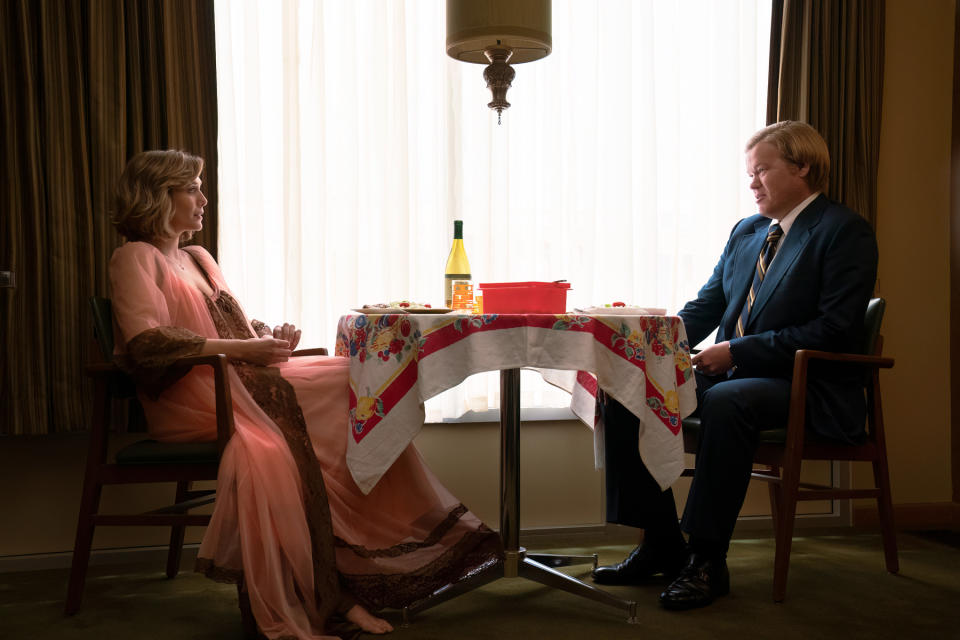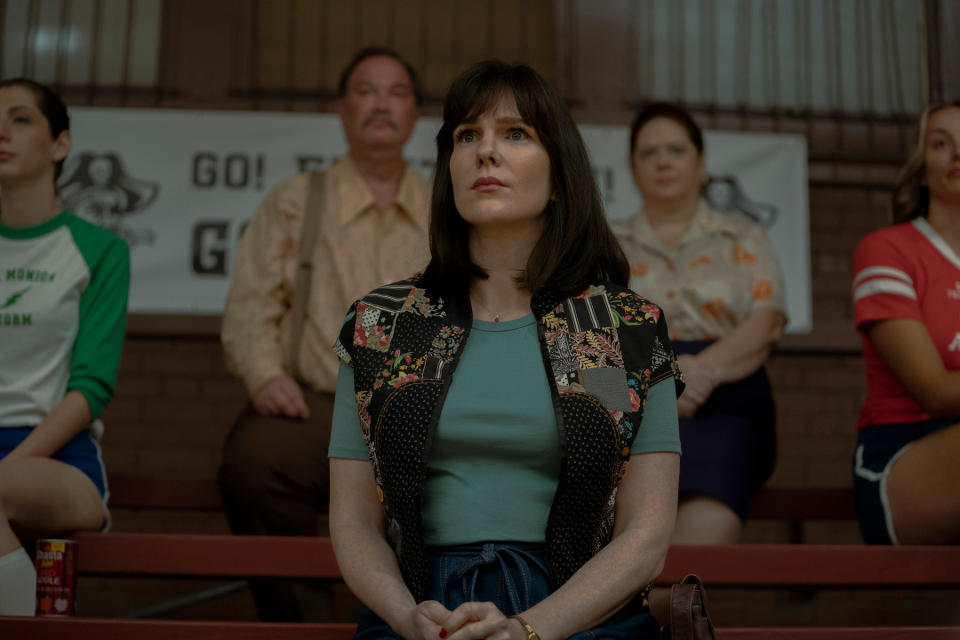‘Love & Death’ Boasts a Delightfully Gonzo Elizabeth Olsen and Little Else
- Oops!Something went wrong.Please try again later.
- Oops!Something went wrong.Please try again later.

Why does the new HBO Max miniseries Love & Death exist?
On a certain level, yes, I understand why it exists. This is prime Emmy-bait season, and the role of Candy Montgomery — a Texas housewife who, on a warm Sunday in 1980, killed her friend Betty Gore, striking her with an axe 41 times — is an obvious awards play for star Elizabeth Olsen. It may also be for supporting actors like Jesse Plemons, who plays Betty’s husband — and, crucially, Candy’s lover — and for its Emmy-adored creator David E. Kelley (Big Little Lies), and for chief director Lesli Linka Glatter (Homeland). Plus, true-crime docudramas remain one of television’s most durable genres, with Hollywood executives looking at infamous murders as just another form of IP.
More from Rolling Stone
'Barry' Season 4 Finds Its Funny Thanks to an SNLer and a Legendary Director
'Succession': The Roy Siblings Meet Their Match in Alexander Skarsgård's Lukas Matsson
But, specifically, why does this true-crime docudrama exist? This will be the third time an actor is playing Candy on television. Barbara Hershey did it in a 1990 CBS movie called A Killing in a Small Town. More crucially, Jessica Biel played Candy less than a year ago in the Hulu miniseries Candy, which co-starred Melanie Lynskey as Betty, and even featured the stars’ husbands, Justin Timberlake and Jason Ritter, in small roles as two cops working the case.
What is so special, so fascinating, so essential that the story of this one particular killing has to be told over and over again? Perhaps each creative team has a unique and deeply insightful take on the case that demands public consumption. Maybe Candy and Betty’s tragedy can be used to make a wide variety of larger points about female friendships, changing sexual mores, the intersection between spectacle and criminal justice, or anything. Maybe it’s a Rorschach test, and every writer and director sees something different when they look at Candy swinging that axe, over and over and over again.
Unfortunately, there’s not a lot of recent evidence of that. I cannot speak to the quality of A Killing in a Small Town, which aired when I was in high school. Candy, though, featured good performances from Biel, Lynskey, and their co-stars, and one unbearably tense episode set on the night Betty’s body was discovered — along with her baby, who was left crying in her crib for hours before anyone got into the house. But it never figured out what it had to say across its other four episodes beyond, “This was pretty crazy, right?”

Love & Death is seven episodes in total, which should in theory have given Kelley, Linka Glatter, and everyone else even more time to enumerate what is important about this tale. But other than some strong work from Olsen, this new take seems just as lost as its Hulu counterpart was at trying to find a deeper meaning here.
Odds are the only people who will watch both shows are TV critics and people who worked on one and are curious about the other. Nonetheless, if you’ve seen Candy, you not only already know all the details, but will be shocked by how many of the beats of the story are presented in identical fashion. Without doing a side-by-side comparison, it felt like a half-dozen scenes in each installment were practically word-for-word from the respective Candy scenes, like Candy frantically running through her phony alibi again and again for anyone within earshot in the hours before people find out about Betty. Eventually, I made a game out of trying to spot the minor differences, like how in Candy, Candy’s boring husband, Pat (played there by Timothy Simons), ignores her advances while watching The Rockford Files, while here (now played by Patrick Fugit), he’s watching The Tonight Show.
There are a few crucial deviations, though. The first is that the story is (after a brief prologue) told in strictly chronological order, where Candy bounced around in time for a bit. Mostly, Kelley uses this as a chance to spend more time on Candy and Allan’s fling, which began not as some kind of heated affair, but as a convenient, almost businesslike outlet for two sexually frustrated people who otherwise loved their respective spouses. Even before they begin sleeping together, they have to go through an elaborate series of negotiations, pros and cons lists, drafting of rules, etc., to ensure that no one gets hurt by this — even though, ultimately, everyone got very, very hurt by it, Betty most of all.
Speaking of which, the second significant change from the Hulu version is that Candy felt equal empathy for both killer and victim. Love & Death, on the other hand, is entirely in Candy’s corner, and barely even considers the inner life, or the sadness of the death, of poor Betty Gore. The Lynskey version is clearly depressed and isolated, but the Lily Rabe version is simply presented as an insufferable shrew who chased Allan into adultery. (Even when they have sex, it’s terrible, like when we see her barking orders at him as they try to conceive another child: “If you can squirt rather than drip, that helps too! But slower! Deeper! And squirt!”) The sequence where Allan — off on a business trip and increasingly panicked that Betty isn’t answering the phone — has to goad his neighbors into breaking into the house is shorter and less harrowing than the Candy version, as if Kelley and company are reluctant to make us appreciate just how terrible this all was. In later episodes, we see glimpses of Betty’s parents struggling with both their grief and their outrage that their son-in-law’s philandering led to this, but for the most part, that is treated as besides the point of understanding who Candy was and how she got to this moment of extreme violence.
And for that part of the story, it’s hard to think of an actor better suited than Elizabeth Olsen. As we saw throughout WandaVision, and in many of her film roles, she excels at playing characters who seem outwardly happy and well-adjusted, while hiding deep inner damage. Her friend and attorney Don Crowder (Tom Pelphrey from Ozark) at one point refers to Candy as “the most normal person I know,” and Olsen makes it easy to understand why people would still think that, even after finding out about what she did to Betty. But she also shows how much of this is a facade, particularly whenever Candy is trying to psych herself up by singing along to songs of the day(*), like ABBA’s “Take a Chance on Me.” This is someone who who looks like the queen of her local church, and is treated as such by most of the parishioners(**), but who is harboring a lot of darkness, even beyond her dissatisfaction in her marriage. Olsen shows all of that well, and is extremely watchable throughout.
(*) Where Jessica Biel sported a period-appropriate permed helmet like the real Candy, Olsen is styled with much softer, shoulder-length curls, not too dissimilar from what a woman might wear today. In general, Linka Glatter aims for the story to look and feel as contemporary as possible, even if there are distinctly late-Seventies elements, like both couples attending a church-run Marriage Encounter getaway at different points.
(**) Elizabeth Marvel, who’s also great right now on Peacock’s Mrs. Davis, has a good supporting role as the local minister, who is also Candy’s best friend. When she departs for another congregation, both Candy and Betty struggle to get along with her young and abrasive replacement, played by Keir Gilchrist from Netflix’s Atypical. The material about church politics is among the more specific and interesting threads of the whole show.

But tilting the narrative entirely toward Candy does a disservice to both the Gores — Plemons gets little to play other than bland detachment from everything good and bad in his life — and to the storytelling as a whole. Because we only see Candy’s side of things, the later episodes about her trial feel redundant, even with Don showboating in front of the unhappy judge (played by the great character actor Bruce McGill). Ex-lawyer Kelley became a superstar showrunner in the Eighties (L.A. Law) and Nineties (The Practice, Ally McBeal) because of his mastery of courtroom drama. In recent years, though, it feels like he’s been mailing it in when depicting his former profession — which is a problem when so much of Love & Death builds up to what happens during testimony by Candy and others. The show seems most alive in dealing with Candy and Allan’s affair, as if the killing is the thing that got a greenlight, but not something worth exploring in great depth.
Whether you know the story from previous articles and dramatizations, or it’s brand-new to you, Love & Death never really justifies why all these talented people have come together to re-create this particular crime. Candy came and went with barely a ripple last spring, with its lone Emmy nomination coming for the design of its opening credits. As we see every network and streamer save all of their awards hopefuls for the March-April-May window right before voting begins, it’s become impossible for both regular viewers and Emmy voters to keep up with it all. Maybe the slightly bigger names in this cast, plus the Kelley/Linka Glatter team, will attract more attention. But it’s hard not to wish all this talent had been thrown at a different story about which everyone had more to say.
The first three episodes of Love & Death begin streaming April 27, with additional episodes releasing weekly. I’ve seen the whole thing.
Best of Rolling Stone

